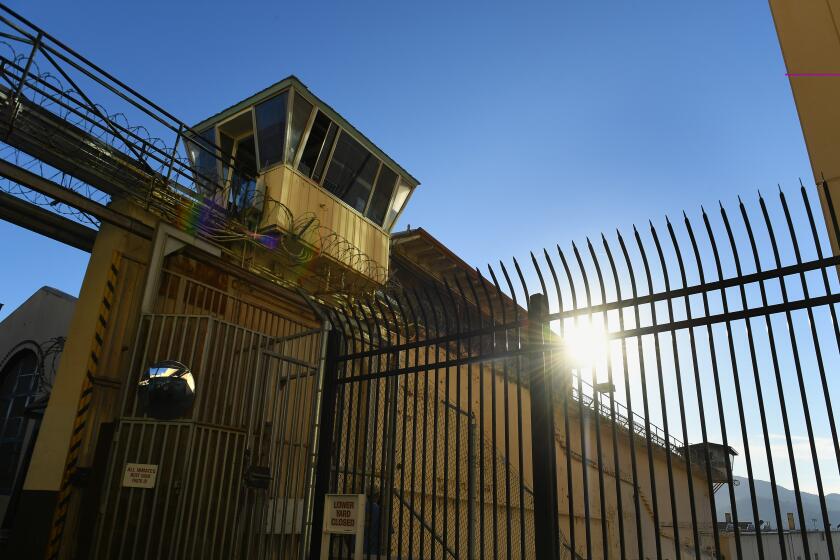Editorial: Can L.A. County jails end the culture of violence against inmates?

After three years of turmoil arising from abuse of jail inmates, the Los Angeles County Board of Supervisors on Tuesday agreed to outside monitoring of nearly all aspects of its jail operation.
The settlement of a class-action lawsuit, known as the Rosas case after the lead plaintiff, caps a period in which reporting in The Times and elsewhere led to hearings and recommendations by a Citizens Commission on Jail Violence, the resignations of Sheriff Lee Baca and Undersheriff Paul Tanaka, an FBI investigation, imprisonment of seven deputies for obstructing that investigation and the election of Sheriff Jim McDonnell.
Compared with those high-profile actions, the lawsuit may be one of the less spectacular results of the department’s breakdown. But it will have important consequences. The settlement imposes a long list of policy directives on the department, covering, among other things, the training of deputies, the use of force, data and complaint tracking, and staffing — all focused on correcting the failures that led to the mistreatment of inmates and to reducing the number of future incidents.
The U.S. Department of Justice is not involved in the suit, but the settlement is in essence a consent decree, similar in some ways to the decree under which the Los Angeles Police Department operated for more than a decade until the middle of last year.
Three monitors will oversee implementation and report to the court on progress. Appointees include Richard Drooyan, who served as chief counsel to the jail violence commission and headed a team that oversaw implementation of that panel’s recommendations. And that’s appropriate; many of the settlement’s directives echo those earlier recommendations, such as keeping an assistant sheriff in charge of the Sheriff’s Department’s custody operations, and preparing and adhering to a manual that details when and how deputies are authorized to use force against inmates.
The other monitors are corrections experts Jeffrey A. Schwartz and Robert P. Houston.
The directives, if implemented properly, should protect inmates from beatings, well-meaning deputies from mismanagement by superiors, and the public pocketbook from some large damage awards. They will play a key role in making Los Angeles County jails humane and safe places to await trials and serve sentences.
But it would be a mistake to see the Rosas settlement as merely the conclusion of an unfortunate three-year period in which the sheriff’s jail operations went off the rails.
The problems in the department were not limited to three years or even to Baca’s full 15-year tenure. On the contrary, Rosas is an outgrowth of a 39-year-old lawsuit known as Rutherford, and monitoring of jail conditions as a result of that case continues today.
That should serve as a sobering reminder that it is not necessarily enough to identify problems and promise to fix them. Such promises have been in place for 40 years, and they resulted from events that have a distressing ring of familiarity today.
In 1991, after several deputy shootings of non-white suspects, the Board of Supervisors convened a panel under the leadership of retired Los Angeles County Superior Court Judge James G. Kolts to investigate the Sheriff’s Department’s handling of excessive force cases. The Kolts Commission found many of the same breakdowns cited 20 years later by the panel that Drooyan served. Supervisors and the sheriff created a special counsel to monitor the department, and an Office of Independent Review to report on the sheriff’s internal investigations. Already in place was a commission charged with monitoring jail conditions. Problems continued to fester.
The culture of deputy violence against inmates — a culture that too often has disregarded the rights and humanity of inmates — is inextricably linked to failures in the operation, management and oversight of the Sheriff’s Department and to the inadequacy of the jail facilities. Ensuring that change in the jails is positive and permanent requires strengthening civilian oversight of the Sheriff’s Department, demolishing and replacing Men’s Central Jail, diverting the mentally ill to treatment when their conditions require care rather than lockup, taking other steps to responsibly reduce the inmate population, and providing the department with adequate resources to operate properly.
Rutherford and Rosas, with their ongoing monitoring requirements, together with another recent settlement under which the county acknowledged that it inadequately accommodates inmates with physical disabilities, plus a yet-to-be-concluded consent decree with the U.S. Department of Justice over mistreatment of mentally ill inmates and the still-unfulfilled recommendations of the Citizens Commission on Jail Violence, provide a patchwork of monitoring and mandates to improve the jails.
In total, the agreements are reminiscent of the LAPD consent decree. But they lack the coherence of the LAPD consent decree, with its single set of mandates, single judge and single monitoring team. It is by no means a foregone conclusion that, singly or collectively, the decrees, settlements and recommendations will enable the Sheriff’s Department to make the turnaround it needs.
The challenge for the county, and especially for McDonnell, is to respond with a remediation program that coherently weaves together the various mandates and monitoring schemes, and to do it in a way that allows the Sheriff’s Department to finally emerge from decades of substandard jailing. It will require continuing focus by the sheriff, the Board of Supervisors and the public to ensure that the problems in the jails do not fester for another 40 years.
Follow the Opinion section on Twitter @latimesopinion
More to Read
A cure for the common opinion
Get thought-provoking perspectives with our weekly newsletter.
You may occasionally receive promotional content from the Los Angeles Times.










